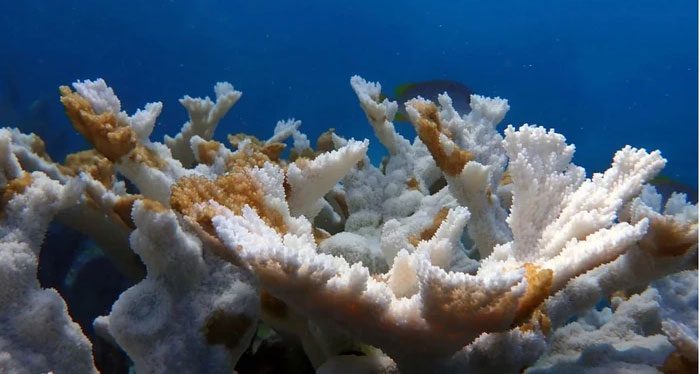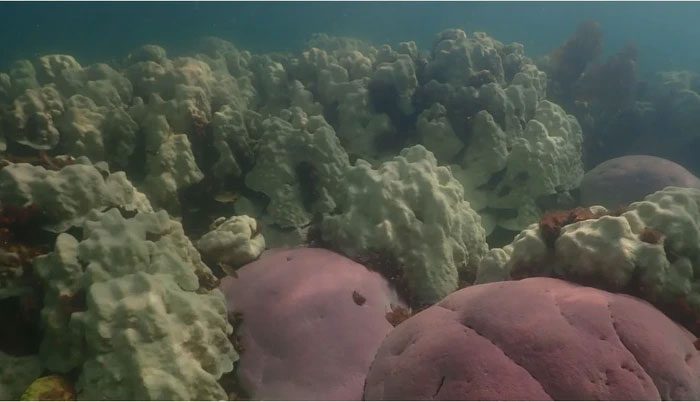This phenomenon serves as a strong warning to humanity globally.
Coral Turned White
According to CNN, an emergency rescue campaign is underway to save coral species in the Florida Keys archipelago from the risk of extinction due to unprecedented widespread increases in water temperatures leading to coral bleaching and mass deaths.
Coral experts predict that bleached reefs will “completely die” within just a week, and they are concerned that deeper reefs may face a similar fate if ocean warming continues.
Extreme heat, lack of rain, and winds have pushed water temperatures around Florida to record highs. A buoy at a depth of 1.52 meters recorded a temperature of 38 degrees Celsius on July 24 in the Gulf of Florida. Many other monitoring stations in the area exceeded 35.5 degrees Celsius, with one station reaching 37 degrees Celsius, according to the National Data Buoy Center.
Coral is extremely sensitive to temperature changes. Prolonged high temperatures can lead to coral bleaching.

Coral bleaching due to hot weather. (Photo: CNN).
According to The Guardian, during this process, corals will “expel” the colorful algae that live within the tiny pores of the coral, which give corals their vibrant colors and provide most of the energy they need. If this process continues for too long, the coral species will die and risk being overrun by other organisms, such as algae.
The temperature at a coral reef managed by the Florida Aquarium was recorded at 32.7 degrees Celsius on July 6. At that time, the coral was completely healthy, but when the technical team returned on July 19, all the coral had turned white, with an estimated 80% of it dead.
Another report from the Coral Restoration Foundation indicated that “100% of the coral is dead” at the Sombrero Reef off the coast of Marathon in the Florida Keys.
“This is like all the trees in a rainforest dying. Where will all the other animals that depend on the rainforest live? This is the underwater version of a rainforest. Coral plays a similarly fundamental role,” said Keri O’Neal, Director and Senior Scientist at the Florida Aquarium.
Andrew Ibarra, a monitoring specialist at the Florida Keys National Marine Sanctuary, noted: “I see the entire coral reef turned white. Every coral population is showing signs of bleaching, partially or completely white, including some reefs that have recently died.”
Photos and videos provided by Ibarra depict “a terrifying coral graveyard, stripped of color and life.”
“The images are truly horrific,” said Katie Lesneski, monitoring coordinator for the National Oceanic and Atmospheric Administration (NOAA). “It’s hard for me to put into words how I feel right now.”
Lesneski revealed that she is aware of two other reefs with “very, very high mortality rates,” but also found “a glimmer of hope” when diving at a deeper reef on July 24, where only 5% of the corals began bleaching due to slightly cooler water temperatures in that area.
Counterintuitive Actions
However, according to CNN, even reefs in these cooler water areas could bleach and die if ocean temperatures continue to rise.

“Coral graveyard” in the Gulf of Florida. (Photo: CNN).
Coral restoration experts are currently selecting genetically important species from nurseries—where corals are bred—and relocating them inland to await cooler ocean waters.
“Scientists are working hard to protect what we have. It’s crazy that the best solution we have right now is to pull as much coral out of the ocean as possible,” O’Neill told CNN. “You’ll be shocked to think about that.”
The Keys Ocean Laboratory at the Florida Institute of Oceanography has received at least 1,500 coral fragments and hopes to increase this number to 5,000 or more as the rescue campaign progresses. Here, the corals will be nurtured in temperature-controlled water.
Biologist and laboratory director Cynthia Lewis told CNN: “We are in emergency sorting mode right now. Some species of coral brought in last week look terrible, and we may lose them.”
According to Bloomberg, recently, ocean regions around the world have reported significant temperature increases, partly driven by climate change. Along with the formation of the El Niño weather pattern, global sea surface temperatures in June hit their highest levels in 174 years.
Ocean warming not only affects underwater organisms but, according to marine scientist Deborah Brosnan, this phenomenon also exacerbates weather-related disasters, claiming lives and causing significant economic damage. It is estimated that damages could rise to $1 trillion annually in the coming decades.


















































